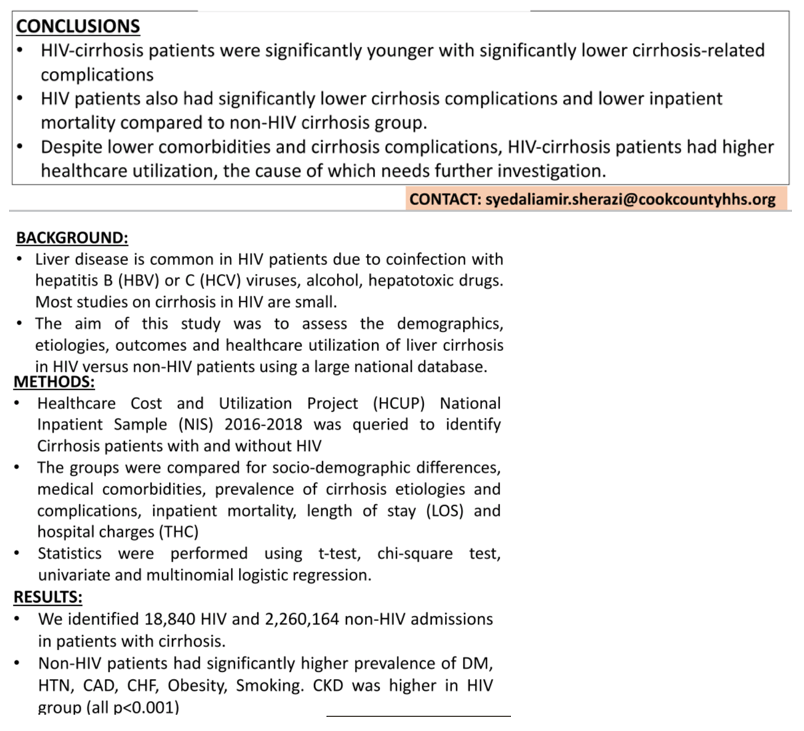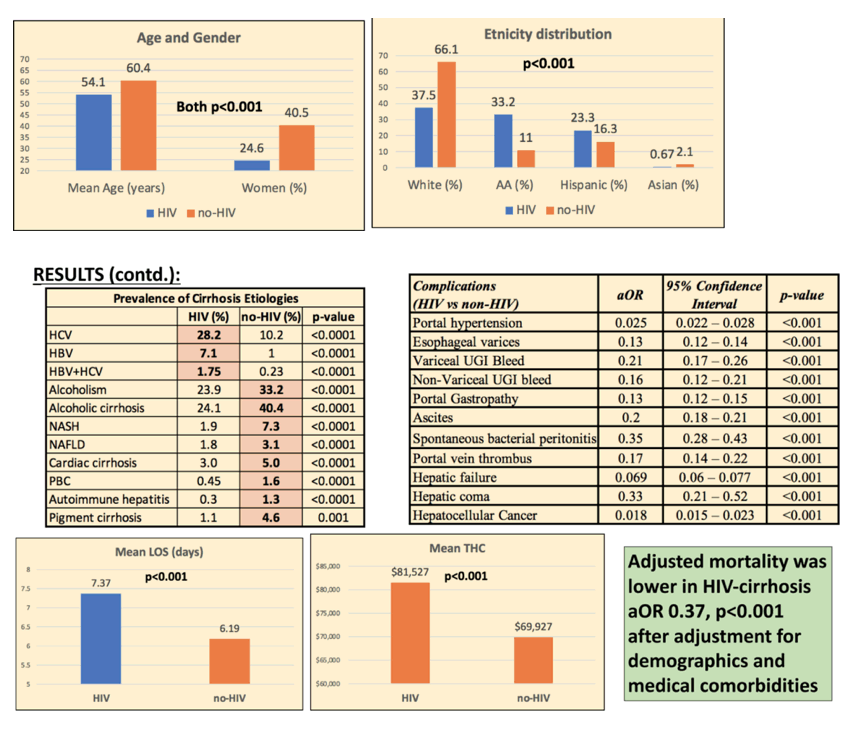 |
 |
 |
| |
CIRRHOSIS IN HIV VERSUS NON-HIV PATIENTS - ANALYSIS OF DEMOGRAPHICS, OUTCOMES AND HEALTHCARE UTILIZATION FROM A NATIONAL DATABASE - Ethnic Disparities, PLWH Have Longer Hospital Stays & Greater Hospital Charges
|
| |
| |

HIV-cirrhosis group was significantly younger (mean age 54.1 vs 60.4 years p<0.001), significantly more likely to be men, African American and Hispanic, from poorest income zip-codes, on Medicaid, treated at urban teaching and large sized hospitals compared to non-HIV group
Background:
Liver disease is common in HIV patients due to co-infection with hepatitis B (HBV) or C (HCV) viruses, alcohol, hepatotoxic drugs. Most studies on cirrhosis in HIV are small. The aim of this study was to assess the demographics, etiologies, outcomes and healthcare utilization of liver cirrhosis in HIV versus non-HIV patients using a large national database.
Methods:
The United States Healthcare Cost and Utilization Project's National Inpatient Sample (HCUP-NIS) 2016-2018 was queried to identify patients with cirrhosis, with and without HIV using ICD-10 codes. We studied patient and hospital demographics, co-morbidities, cirrhosis etiologies, complications, mean length of stay (LOS), mean Total Hospital Charges (THC), adjusted odds ratio (aOR) for all cause mortality. Statistical analysis utilized chi-square test, univariate and multinomial logistic regression.
Results:
A total 18,840 HIV-cirrhosis and 2,260,164 non-HIV cirrhosis admissions were identified. HIV-cirrhosis group was significantly younger (mean age 54.1 vs 60.4 years p<0.001), significantly more likely to be men, African American and Hispanic, from poorest income zip-codes, on Medicaid, treated at urban teaching and large sized hospitals compared to non-HIV group (all p<0.0001). Hypertension, Diabetes, Dyslipidemia, Coronary artery disease, Heart Failure, obesity, smoking was significantly higher in non-HIV group (all p<0.001) while chronic kidney disease, malnutrition and sepsis were higher in HIV-group (all p<0.001). Rates of HCV, HBV were higher in the HIV-group (p<0.001) while alcoholism, alcoholic cirrhosis, Non-alcoholic steato-hepatitis (NASH), cardiac and pigment cirrhosis was higher in non-HIV group (all p<0.001). All cirrhosis complications were significantly lower in HIV-cirrhosis group (Table1). After adjusting for patient and hospital demographics, LOS (7.37 vs 6.19, p<0.001) and THC ($81,527 vs $66927, p<0.001) were significantly higher in HIV-cirrhosis group. The aOR for mortality for HIV-cirrhosis was 0.37 (0.32-0.43, P<0.001) after adjustment for patient and hospital demographics and medical co-morbidities.
Conclusion:
HIV-cirrhosis patients were significantly younger with significantly lower cirrhosis-related complications and lower mortality compared to non-HIV cirrhosis group. Despite this, HIV-cirrhosis patients had higher healthcare utilization, the cause of which needs further investigation.


|
| |
|
 |
 |
|
|